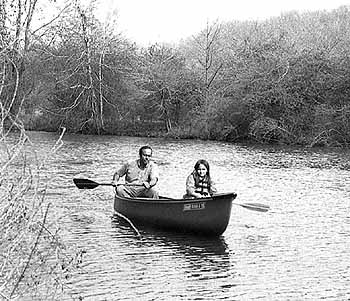gfdl's home page > people > Anand Gnanadesikan's home page
Anand Gnanadesikan
Oceanographer
Geophysical Fluid Dynamics Lab
PO Box 308, Princeton NJ 08542
Anand.Gnanadesikan@noaa.gov
|
|
|
|
Anand and Gita on
Cranbury Brook |
Science Olympiad Students click here
Professional Interests
My research centers on the physical processes governing global-scale vertical exchange in the ocean, and the effect of this vertical exchange on climate and global biogeochemical cycling.
Mixing and stirring and the resulting effects on oceanic processes.
How is the large-scale circulation of the ocean driven? In a series of papers building on the work of Robbie Toggweiler I argue that the most important driving mechanisms are winds and eddies, rather than small-scale turbulent mixing.
The key to understanding the ocean circulation is the density budget maintaining various pools of light water. These pools are largely renewed by the wind. A particularly important process is the wind-driven upwelling of deep waters in the Southern Ocean, which feeds the Subantarctic Mode Water and Antarctic Intermediate Water. However eddy processes can counteract this.
Click here for more information.
Biogeochemical cycling
I've worked in a number of areas of biogeochemical cycling in the oceans, including the cycles of silicon, phosphate, and carbon. I'm also investigating the impact of fertilization strategies for mitigating atmospheric emissions of carbon dioxide.
Click here for more information.
Click here to access some information about our participation in the Ocean Carbon Model Intercomparison Project.
Click here to see results from our work on the Southern Ocean Biogeochemical Divide.
Representing oceanic processes in ocean models
A third major area of my research relates to representing oceanic processes in ocean models. Areas in which I've worked include work on the representation of eddies, topography, and overflows. Recent work has looked at the impact of changing the absorption of sunlight within the ocean on global climate.
Click here for a description of this research on "Earth and Sky", a global radio program.
GFDL Ocean Model Development Team: ( GFDL Only ) I am currently a member of this team, working on developing the next generation of the GFDL Ocean models.
Click here for a bibliography including preprints and links to papers.
Education
I teach in the Atmospheric and Oceanic Sciences Program. My teaching interests include:
Click here to access information about Geology 425. Introduction to Physical Oceanography which I taught in the fall of 1998. An updated site for the last two years can be found here .
Click here to go to the blackboard.princeton.edu web site, which has the course notes for Geology 220, Weather and Climate, which I taught in the Spring of 2002.
Previous Work
This refers to work that I did as a graduate student in the Upper Ocean Processes Group at Woods Hole.
Upper ocean dynamics. Dynamics of the mixed layer and its effect on chemical cycling. This work has focussed on understanding how small scale turbulent mixing in the upper ocean affects the spatial structure of fields (such as velocity and chemical tracers) which have some natural decay time. Click here for more info.
Mixing and stirring in small-scale laboratory systems.

